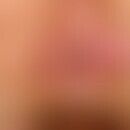Synonym(s)
HistoryThis section has been translated automatically.
Fox, 1878; Lewandowsky, 1917;
DefinitionThis section has been translated automatically.
Lupus miliaris disseminatus faciei (LMDF) is an idiopathic granulomatous disease affecting mainly the facial skin. Nosologically, it belongs to the spectrum of facial granulomatous dermatoses and has overlap with rosacea and sarcoidosis. In most cases, this disease resolves spontaneously within a few years, but may leave disfiguring scars.
You might also be interested in
EtiopathogenesisThis section has been translated automatically.
The etiology of lupus miliaris disseminatus faciei (LMDF) is unclear. Probably polyetiologic skin reaction. Originally, the lesions were thought to be associated with tuberculosis because the clinicopathologic findings resemble those of other tuberculids (the term tuberculid was used in the past to refer to reactive conditions associated with tuberculosis in which the actual infectious agent is found elsewhere and not in the skin lesions). Today, however, LMDF does not occur in association with pulmonary tuberculosis. The disease also does not respond to antituberculous drugs (unlike true tuberculids). Tuberculin skin tests are usually negative in these patients (Nino M et al 2003).
Furthermore, major investigations, including histochemical staining for mycobacteria and tissue culture and PCR-based studies, have failed to detect M. tuberculosis organisms in LMDF granulomas (Hodak E et al. 1997; Chougule A et al. 2018). A possible association with an unknown non-tuberculous mycobacterium has not been completely ruled out.
Whether, as often postulated in other facial granulomatous eruptions, an altered antigenicity of the hair follicle or sebaceous gland structures with subsequent T-cell-mediated destruction or another disorder of the "pilosebaceous unit" is causative is not certain. A connection with hormonal effects, as observed in certain acneiform variants, has not been demonstrated.
PathophysiologyThis section has been translated automatically.
Some authors consider LMDF to be a variant of granulomatous rosacea, while others argue that LMDF should be considered a separate entity (Berbis P et al 1987). It can be hypothesized that the various clinical manifestations of rosacea are due to the same underlying inflammatory pathways, including abnormalities of the innate immune system and neurovascular aberrations. However, the vascular abnormalities of rosacea are not observed in patients with LMDF. Demodex folliculorum mites are frequently found in skin biopsies from patients with rosacea but not consistently in skin biopsies from patients with LMDF. The extent to which Propionibacterium acnes bacteria play a pathogenetic role is still unclear.
ManifestationThis section has been translated automatically.
LMDF is rare, although exact incidence rates are not widely reported. LMDF can occur in a wide range of ages but is most common in young adults (33 years was the mean age in one series ) and is rare in older adults.
No clear gender predilection has been noted, although in one retrospective study the mean age of female patients (43 years) was higher than that of males (23 years), and all patients beyond the mid-30s were female.
LocalizationThis section has been translated automatically.
Especially face.
The lower eyelids are most commonly affected, but the forehead, cheeks, nose, upper lips, ears, chin, or neck are also frequently involved. Involvement outside the face is rare but has been reported in some cases, including the trunk, extremities, and genital skin (van de Scheur MR et al. 2003).
ClinicThis section has been translated automatically.
Chronically persistent, disseminated, often symmetrically arranged, 0.2-0.4 cm in size, blue- to brownish-red, hemispherical, firm (usually follicular) papules or also papulopustules. The individual efflorescences do not confluence, but leave the intervening skin unchanged. Diascopic: Lupoid infiltrate. Sometimes itching or burning of the facial skin is reported.
HistologyThis section has been translated automatically.
Patchy, dense, predominantly follicular, rarely perivascular infiltrates of lymphocytes, neutrophilic granulocytes, epithelioid cells with giant cells, lymphocytes, and plasma cells. Dilated blood and lymphatic vessels, edema of the dermis. There is a tendency for inflammatory infiltration of the follicular epithelium. The follicles themselves may be dilated and contain (sometimes numerous) follicular mites.
Four stages of perifollicular inflammatory reaction have been described:
- Epithelioid cell granulomas with central necrosis.
- Epithelioid cell granulomas with central necrosis (sarcoid/foreign body reaction).
- Epithelioid cell granulomas with abscesses
- Non-granulomatous, non-specific perifollicular inflammatory infiltrates. Concomitant neutrophilic granulomas with or without neutrophilic microabscesses have been observed variably.
- Late lesions show fibrosis that correlates with clinical scarring.
There is significant histologic overlap with granulomatous rosacea and other facial granulomatous disorders.
Differential diagnosisThis section has been translated automatically.
Lupoid rosacea or lupoid perioral dermatitis cannot be seen as a "true" differential diagnosis, as there is probably idendity of both syndromes.
Acne vulgaris (younger age group, mostly pustular, evidence of comedones and fresh follicular pustules)
Small-nodular sarcoidosis (histologically absent necrotic zones).
Papulosquamous syphilides (exclusion by serologic testing; clinically, follicular reference of syphilides is always absent; usually palpable lymph nodes, syphilides of palms).
TherapyThis section has been translated automatically.
The clinical picture is characterized by resistance to therapy. Consistent patient management is important; use of unknown cosmetics should be strictly discouraged. The disease usually responds poorly to topical or systemic therapies, which are the first choice in granulomatous rosacea. Early, effective treatment may reduce the risk of significant scarring.
Tetracyclines: The efficacy of oral tetracyclines is only moderately good (e.g., doxycycline 50-100 mg/day or minocycline (e.g., clinomycin). Systemic therapy initially for 6-8 weeks, then pause therapy for 4 weeks, repeat therapy cycle if necessary.
Isotretinoin: Response to isotretinoin is inconsistent (dosage initially: 0.2-0.3 mg/kg bw/day. Continuous therapy with 10 mg/day. Caucuses of treatment with retinoids must be observed). In one series, patients responded better to oral prednisolone (administered at an initial dose of 10 mg daily) or oral dapsone (100 mg daily). The combination of these two agents appeared to be particularly effective, even in patients in whom monotherapy with either agent had failed. In the same series, it was reported that the combination of oral dapsone with topical tacrolimus resulted in an excellent response in 7 of 7 patients (Al-Mutairi N 2011).
Alternative: Other studies also report a good response to systemic corticosteroids (Dev T et al. (2017).
Alternative: Hydroxychloroquine: dosage initially 2 times/day 200 mg p.o. and continuing 1 time/day 200 mg/day p.o..
Progression/forecastThis section has been translated automatically.
Mostly chronic course over 1-2 years. Healing leaving behind delicate atrophic scarring.
TablesThis section has been translated automatically.
Locally effective antibiotics in the treatment of lupus miliaris disseminatus faciei
Active substance |
Preparation form |
Example preparations |
Tetracycline |
3% ointment |
Imex ointment, Achromycin ointment |
Erythromycin |
2% solution |
Aknemycin solution |
1% emulsion |
aknemycin emulsion |
|
2% ointment |
Aknemycin ointment |
|
Clindamycin |
1% gel |
Zindaclin, Basocin Acne Gel |
1% solution |
Basocin Acne Solution |
Note(s)This section has been translated automatically.
The name derives from a historical presumed association with tuberculosis. Older names for a similar granulomatous dermatosis of the face include:
- micropapular tuberculosis
- Lewandowsky rash
- lupoid rosacea.
- Acne agminata was used for similar lesions in the axilla.
Case report(s)This section has been translated automatically.
The 42-year-old patient had been suffering from disseminated papules on the face for about 1/2 year; he was otherwise skin-healthy. No history of acne.
Findings: Disseminated, centrofacially accentuated, 0.1-0.4 cm, brownish-red, firm, sporadically scratched, follicular papules and few papulopustules. Diascopic: lupoid infiltrate. The patient complained of mild pruritus. Ultimately, the findings were primarily cosmetically disturbing. Histologically, there was a tuberculoid granuloma with central necrosis and patchy lymphocytic infiltrates. Serial sections showed evidence of a ruptured follicle.
Therapy: Minocycline 100 mg/day p.o. for 6 weeks without success. Topically 2% tinted metronidazole cream. Switch to isotretinoin, initially 20 mg/day p.o. and subsequently 10 mg every 2nd day. Gradual calming of the clinical picture.
LiteratureThis section has been translated automatically.
- Al-Mutairi N (2011) Nosology and therapeutic options for lupus miliaris disseminatus faciei. J Dermatol 38:864-873
- Berbis P et al (1987) Lupus miliaris disseminatus faciei: efficacy of isotretinoin. J Am Acad Dermatol 16:1271-1272.
- Chougule A et al (2018) Granulomatous rosacea Versus lupus miliaris disseminatus faciei-2 faces of facial granulomatous disorder: A Clinicohistological and Molecular Study. Am J Dermatopathol 40:819-823.
- Fox T (1878) Lupus miliaris disseminée ou lupus folliculaire. Lancet 2: 75
- Hodak E et al (1997) Lupus miliaris disseminatus faciei--the DNA of Mycobacterium tuberculosis is not detectable in active lesions by polymerase chain reaction. Br J Dermatol 137:614-619.
- Nino M et al (2003) Lupus miliaris disseminatus faciei and its debated link to tuberculosis. J Eur Acad Dermatol Venereol 17:97.
- Sehgal VN et al (2005) Lupus miliaris disseminatus faciei part II: an overview. Skinmed 4:234-238
- Sehgal VN et al. (2005) Lupus miliaris disseminatus faciei. Part I: Significance of histopathologic undertones in diagnosis. Skinmed 4:151-156
- Slater N et al (2023) Lupus miliaris disseminatus faciei. 2023 Feb 5. In: StatPearls [Internet]. Treasure Island (FL): StatPearls Publishing; Jan-. PMID: 32644491.
- Stieler W et al (1988) Lupus miliaris disseminatus faciei. Akt Dermatol 14: 4-6
- Takiwaki H et al (2003) Differences between intrafollicular microorganism profiles in perioral and seborrheic dermatitis. Clin Exp Dermatol 28: 531-534
- van de Scheur MR et al (2003) Lupus miliaris disseminatus faciei: a distinctive rosacea-like syndrome and not a granulomatous form of rosacea. Dermatology 206: 120-123
Incoming links (7)
Disseminated follicular lupus; Lupoid perioral dermatitis; Lupus; Miliarial type primary cutaneous follicle center lymphoma ; Rosacea lupoid; Tuberculosis cutis miliaris disseminata faciei; Tuberculosis lupoides miliaris disseminata faciei;Outgoing links (10)
Acne (overview); Demodex folliculorum; Hydroxychloroquine; Isotretinoin; Lupoides infiltrate; Lupoid perioral dermatitis; Minocycline; Rosacea lupoid; Sarcoidosis of the skin; Syphilide, papulosquamous;Disclaimer
Please ask your physician for a reliable diagnosis. This website is only meant as a reference.










